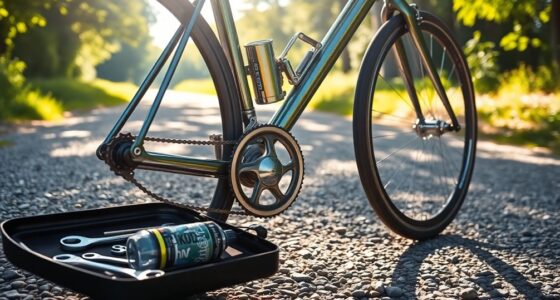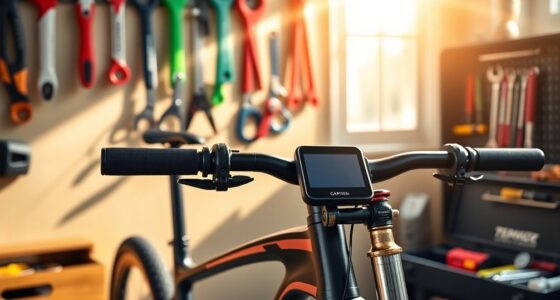To brake properly, start by applying gentle pressure early, then gradually increase it for a smooth deceleration. Pay attention to the feel of your pedal and vehicle response, especially if ABS activates with a pulsation—you should maintain steady pressure, not pump the brakes. Always anticipate stops by watching traffic and keeping a safe following distance. Practicing consistent, controlled braking helps you stay safe and comfortable in any driving situation—continue to explore these techniques for even better control.
Key Takeaways
- Begin braking early with gentle, gradual pressure to ensure controlled deceleration.
- Pay attention to pedal feel and respond appropriately if ABS activates with pulsations.
- Maintain a safe following distance and anticipate stops to avoid abrupt braking.
- Keep foot on the brake until fully stopped, then release smoothly to reduce strain on the braking system.
- Practice consistent, smooth braking techniques for better vehicle control and safer stopping.

Have you ever wondered how to stop your vehicle smoothly and safely? Mastering the proper braking technique is essential not just for your safety, but also for the safety of everyone around you. When you approach a stop sign or red light, you want to reduce your speed gradually rather than slam on the brakes at the last second. This means you should begin braking early enough so that the deceleration feels controlled and comfortable. Press the brake pedal gently at first, then gradually increase pressure as your vehicle slows down. Avoid sudden, hard presses that can cause your vehicle to skid or lose control, especially on wet or slippery roads.
As you brake, pay attention to the feel of the pedal and the response of your vehicle. A smooth, progressive application of pressure helps maintain stability and comfort. If your vehicle has an anti-lock braking system (ABS), you’ll feel a pulsation in the brake pedal when it activates. This is normal and indicates that the system is preventing wheel lockup. In this case, you should continue pressing firmly on the pedal and let the ABS do its work. Do not pump the brakes with ABS; instead, keep steady pressure to allow the system to modulate braking force effectively. Proper braking technique is vital for maintaining vehicle control in various driving conditions.
Timing and anticipation are key to proper braking. Keep a safe following distance from the vehicle ahead so you have ample time to slow down gradually. Keep your eyes on the road and anticipate stops well in advance—notice brake lights, traffic signals, or obstacles early. This foresight allows you to ease off the accelerator and start braking sooner, reducing the need for abrupt stops. When you’re approaching a stop, begin decelerating early and steadily, rather than waiting until the last moment. This approach minimizes sudden jerks and provides a more comfortable ride. Additionally, understanding the benefits of glycolic acid in skin care can remind you of the importance of gradual, controlled processes for optimal results. Furthermore, practicing defensive driving techniques can enhance your overall safety and braking effectiveness.
Once you’ve come to a complete stop, keep your foot on the brake pedal until the vehicle is fully stationary. If you’re parking or stopping for a prolonged period, shift into park or neutral and release the brake gently to prevent unnecessary strain on your brake system. When starting again, release the parking brake smoothly and apply the accelerator gradually to prevent jerks. Practicing these techniques consistently will improve your control over the vehicle and make your stops safer and smoother. Remember, proper braking isn’t just about stopping quickly; it’s about stopping safely and comfortably while maintaining control at all times. Being aware of your surroundings and vehicle safety features can further enhance your braking effectiveness.
Frequently Asked Questions
How Does Weather Affect Braking Performance?
Weather markedly impacts your braking performance. When it’s rainy or icy, roads become slick, increasing your stopping distance and the risk of skidding. Cold temperatures can also reduce brake effectiveness, while wet conditions may cause your tires to lose traction. To stay safe, slow down in poor weather, maintain a greater following distance, and brake gently to prevent slipping. Adjusting your driving to the weather conditions helps you stop safely.
What Should I Do if My Brakes Fail?
If your brakes fail, stay calm and don’t panic. Immediately press the brake pedal hard, then pump it repeatedly to try to build pressure. Shift to a lower gear to slow down using engine braking. Use your horn and signals to alert others. Look for a safe place to steer towards, like a shoulder or an open area. If needed, use the emergency brake carefully, pulling it gradually.
How Often Should Brake Systems Be Serviced?
Braking basics demand diligence; you should service your brake system regularly to prevent problems. Typically, you need to check brakes every 10,000 to 15,000 miles, or at least once a year, depending on driving habits and vehicle use. Don’t delay diagnostics if you notice squealing, squeaking, or soft pedal sensations. Consistent inspections, prompt repairs, and routine replacements keep your brakes reliable, safe, and ready to respond when you need them most.
Can Aggressive Braking Damage My Vehicle?
Aggressive braking can definitely damage your vehicle over time. When you brake suddenly and forcefully, it puts extra stress on brake components, rotors, and tires, leading to faster wear and potential warping or cracking. You might also cause damage to suspension parts and the drivetrain. To avoid costly repairs, it’s best to brake smoothly and gradually, especially in emergencies, to protect your vehicle’s longevity and safety.
What’s the Best Way to Brake on Icy Roads?
When braking on icy roads, you want to be gentle and smooth. Ease off the accelerator gradually, then apply light, steady pressure to the brakes. If your car has anti-lock brakes (ABS), press the brake pedal firmly and hold it; the system will prevent wheel lockup. Avoid sudden movements or sharp braking, as that can cause skidding. Keep a safe distance and stay alert for any sudden stops.
Conclusion
Remember, practicing proper braking techniques can markedly improve your safety on the road. Always start braking early and use smooth, steady pressure to stop effectively. Did you know that over 25% of accidents involve brake failure or misjudged stopping distances? Staying attentive and maintaining your brakes can help prevent these incidents. By mastering safe braking, you not only protect yourself but also others around you. Stay alert, brake responsibly, and keep everyone safe.









